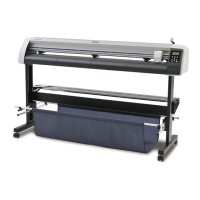3-23
1
1
3
Useful Function
5
6
Cut Out Data with Registration Mark
7
Set the origin.
• After the detection of the registration marks, the display will show the
available cutting area and then return to local mode.
Detecting procedure ( [DIST.REVI.] Setting value is “AFTER”)
1
Follow steps 1 to 3 of “Detecting procedure ( [DIST.REVI.] Setting value is
“BEFOR”)” ( P.3-22)
2
Press the key.
• In case [ROLL. SELECT] is set [ON] ( P.3-18) , select the
number of pinch roller to use.The registration mark detection will
be started after detecting only the sheet width.
• After only the sheet width has been detected, registration mark
detection starts.
• In case the plotter cannot detect any registration marks, it displays
“Error C36 in the registration mark detection” on the display. Set
the sheet again.
3
After the detection of the registration marks, the scale
compensation display appears.
• The right figure shows the 4-point detection display as an
example.
• If there is a difference between the actually measured value and the
detected length, make setting with the jog key or .
• Press the key to change the display to the next scale
compensation setting.
• If [DIST. REVI.] is set to [OFF], the display for scale compensation
setting will not appear.
• If [MARK DETECT] its set to [2ptA], the display for inputting the B length will not appear.
• If [MARK DETECT] is set to [1pt], the display for scale compensation will not appear. Proceed to Step 4
and set the origin.
• For the number of registration marks detected in the Step 2, refer to ”Setting the Number of
Registration Mark Detection”
( P.3-18).
• Be sure to set the sheet in the rear.

